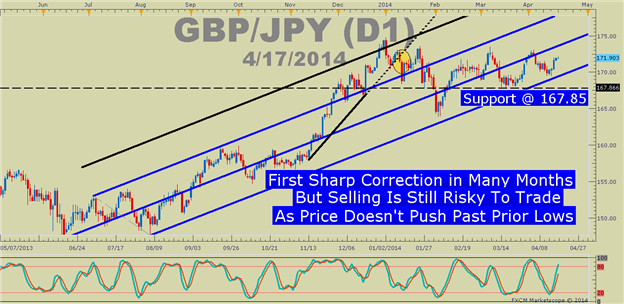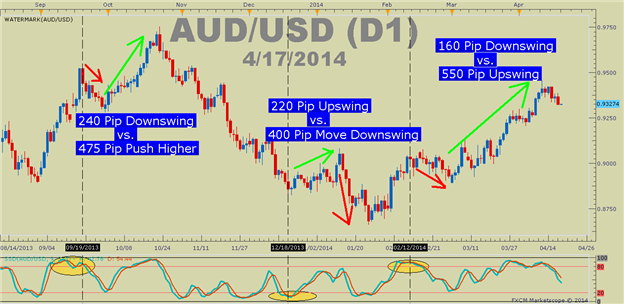Oscillators can be one of the most valuable tools
in a trader’s arsenal. A big reason for its value is that very few
tools can help you see a great risk: reward set-up when a price action
correction is coming to an end. Put in other words, an oscillator helps
you see the exhaustion of a move so that you can enter near the
exhaustion point of a prior trend.
However, it would be a disservice to you if you were
led to believe that a stretched oscillator was a great entry.
Unfortunately, after many new traders learn about the benefits of
oscillators, they believe they’ve received the golden key to trading
profits and start buying low and selling high. A few steps back from the
chart though and you’ll quickly see that only side of the trade is
worth taking based on how price action reacts to an unwinding
oscillator.
Learn Forex: Trading With the Trend Is Always Preferable

Courtesy of Marketscope 2.0
The Pain of Trading Against the Trend
The problem with trading against the trend is that
it works every now and then. However, as a trader, it’s easy to agree
with the words of John Maynard Keynes who said, “Markets can stay
irrational longer than you can say solvent.” This sounds like someone
who thought they had sold the top only to find they entered against a
very strong trend that has no intention in stopping soon.
From talking to thousands of trader’s over the
years, I’ve recognized a handful of reasons for trading against the
trend. While this is not a definitive list, I’ve seen these three play
out over and over again:
- The excitement of being right while everyone else is wrong
- The thought that the trend is overbought and due for a deep set-back
- The feeling that the biggest money will be made on the big turn
It’s not wrong to feel this way. However, for most, it’s not profitable to trade this way and they’re falling prey to mental biases
as opposed to good analysis. The reason that countertrend trading can
be unprofitable for many to trade is because if you enter emotionally,
you often exit emotionally. Exiting emotionally is a nice way of saying
that you exit after a lot of your capital has been eaten up on a bad
trade from the start.
How Price Action & Oscillators Behave Counter-Trend
As you can see from the chart above, the oscillator
often moved from extreme high to extreme low. Extreme lows are usually
anything below 20 and extreme highs are usually anything over 80.
Extreme highs are deemed to be overbought markets ready for a turn lower
and extreme lows are deemed to be oversold and due for a bounce higher.
Learn Forex: Find Out if Price Rises Proportionally To the Oscillator

Courtesy of Marketscope 2.0
This chart brings a little more detail but the idea
is clear. When you’re trading with an oscillator and you realize that
price action is correcting disproportionally to the oscillator you’re
trading against the trend. If you hold onto this type of trade then you
could get steam-rolled when the oscillator unrolls back in the direction
of the overall trend. Given the recent 500+ pip move in AUDUSD
higher, if price unwinds disproportionally to the oscillator, then it
may be best to get out of a short trade or consider rejoining the AUDUSD trend higher while managing your risk.
Now that you're armed with a new way to read trends with oscillators, feel free to try this information out on a FREE Forex Demo Account with access to multiple markets.
No comments:
Post a Comment